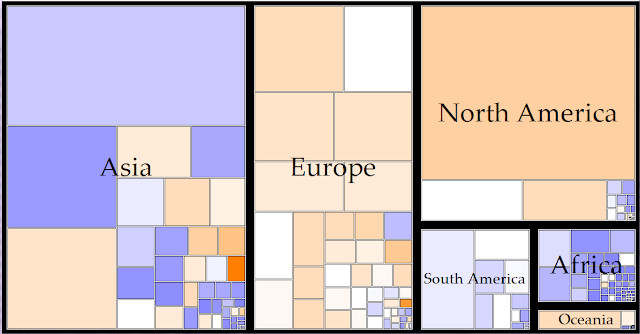A Population Cartogram of New
Zealand
Which depiction of New Zealand (below) is more
representative or accurate?
From a navigational or geographical perspective,
the image on the left is more accurate. But what if you wanted you wanted to
look at the country from another angle, such as population?
If you wanted to get more information on the
population distribution of the country in more detail, a traditional map would
not be very useful, unless you knew the population was distributed perfectly
evenly everywhere.
Obviously, New Zealand’s population is not
distributed evenly. Urban regions will contain more people in a given area, and
rural areas will contain fewer people.
How do you visualise this though?
In this article, I have attempted to this. By
collecting land area and population data for each of New Zealand’s 16 regions,
I have constructed a cartogram (above, right) which re-sizes each region based
on their population. This can be compared with an ordinary map of New Zealand.
While this cartogram and the traditional map of
New Zealand are curious to look at and compare, ordinary bar charts of the
information itself can also add perspective.
These charts show that while Auckland is the
second-smallest region in the country in terms of area, it is by far the most
populous. In fact, Auckland has nearly three times the population of
Canterbury, the second-most populous region in the country.
Wellington, with around 8100 square kilometers,
is the fourth smallest region but the third most populous.
The West Coast region is fifth largest, but has
the lowest population out of all 16 regions, and contains only 1/47th
of Auckland’s population.
Waikato has nearly an equal share of New Zealand’s
population (9.6%) and land area (9.4%)
Land area and population data can be combined to
calculate population density, which in this article is measured in terms of
‘people per square kilometer’.
Auckland, at 312 people per square kilometre is
the most densely populated region in the country, and is over 200 times more
densely populated than the West Coast.
Nelson is an especially unique case. It is the
smallest region and at less than one-tenth the size of Auckland (the second smallest
region), it stands as an outlier in these charts. The Nelson region also has
the second-highest population density.
An expanded cartogram of New Zealand by regional
population is below.
Some obvious points of interest are the increased
size of Auckland and the North Island compared to the rest of the country and
the South Island, but other noteworthy elements include:
- The dramatic decrease in size for the Tasman,
Marlborough, Southland, Otago, West Coast and Gisborne regions. The re-sized
versions of the West Coast and Gisborne regions seem particulary miniscule
compared to their true areas.
- The slight decrease in size for the
Manawatu-Whanganui and Hawke’s Bay regions.
- Northland, Waikato, Bay of Plenty, Taranaki, and
Canterbury remaining roughly the same size.
- Wellington increasing significantly in size.
In the past, the South island regions had a
larger share of the country’s total population than they do now. It would be interesting to have a series of
cartograms based on historical population estimates to see how the location of
New Zealand’s population has changed in the past, and how it might change in
the future.
Sources
Land area data: retrieved from regional council
websites
















